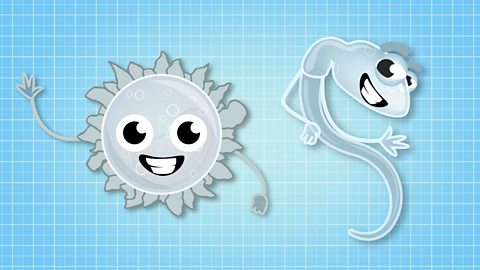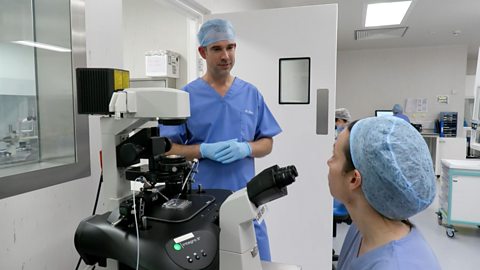When a man and woman decide to have sex in order to make a baby, the man releases sperm to meet an egg inside the womanÔÇÖs body. ItÔÇÖs the most common way that these cells meet.
The sperm leaves through the penis and in order for this to happen, the penis has to become hard and stiff. The medical term for it is an erection and it happens when someone is aroused.
An erection happens when the nerves surrounding the penis become active, causing the muscles to relax and more blood to flow into the penis. This makes it stiff and hard.
Now erections can sometimes happen at unexpected times. DonÔÇÖt worry, itÔÇÖs perfectly natural and it will go back down.
When a woman is aroused, there is an increase in blood flow to the vagina and vulva, and the clitoris which is part of the vulva, swells. Fluids are also released into the vagina to make it slippery.
To make a baby through sex, when both grown-ups are ready and give consent, the manÔÇÖs penis goes into the womanÔÇÖs vagina, and together they move back and forth.
This can create a pleasurable feeling for both the man and the woman, which can increase into something called an orgasm.
During a male orgasm sperm in the testes are squeezed through tubes called sperm ducts towards the base of the penis where it gets mixed with fluid to make semen.
Muscles at the base of the penis then contract, forcing the semen out into the vagina. This reflect action is called ejaculation.
Those sperm are on a mission, just like mini superheroes racing against time to get to the egg with just 12-24 hours to get there.
An egg is released by one of the ovaries each month and it travels into the fallopian tubes. The sperm need to travel here to find it.
Up to 200 million sperm are released when a man ejaculates, but it only takes one to fertilise the egg and start making a baby, and that can only mean one thing ÔÇô itÔÇÖs a race!
We are building up to the start of the race and what a line-up we have.
There can be only one winner. Who will it be?
Sperm, on your marks, get set, go.
And theyÔÇÖre off.
Whoo hoo! Come on number 1,009,324! YouÔÇÖve got this
TheyÔÇÖve got a long way to go and some of the sperm are already beginning to get tired and stop swimming.
WhatÔÇÖs that one doing? ItÔÇÖs going the wrong way
Only the strongest and fastest sperm will ready the egg
And it looks as though number 1,192 is breaking through.!
ItÔÇÖs leaving the other sperm for dust. ThereÔÇÖs no reaching it now, and itÔÇÖs done! ItÔÇÖs the first to reach the egg.
Winner
Now fertilisation has taken place.
The egg and sperm can become an embryo that will hopefully develop into a baby.
Video summary
This short film talks about genitals, arousal, sexual intercourse, and fertilisation.
It sets out that this is something that can happen when a man and woman decide to have sex to make a baby, and that this is the most common method of fertilisation.
The film refers to being grown up and the role of consent in choosing to start a physical relationship.
This film is mainly relevant to sex education although it is also relevant to science. Remember that schools need to be able to draw a line between their curricula for relationships education and sex education in order to implement the parental right to request their child is excused from sex education.
Please ensure you watch the film prior to using it in class, to ensure it is suitable for your pupils and in line with your school's policy for RSHE. Further guidance is given below.
╠²
Before watching the clip
Use baseline assessment to establish current knowledge. Discuss with other teachers and link to their curriculum.
Your teaching must meet the needs of all pupils. Some may be quite shocked by this content if they have not yet encountered it in science lessons.
You should establish what learning has happened in previous lessons about the use of correct terminology and recap on any previous discussions of why correct medical terminology is useful
╠²
Safeguarding
Teaching about sexual intercourse and fertilisation requires sensitive and well-judged teaching based on knowledge of pupils and their circumstances.
Creating a safe space for RSHE lessons is important, including encouraging pupils to respect others through listening and being mindful of otherÔÇÖs feelings.
- Give some thought to what is happening before and after the lesson for those pupils and how to provide opportunities for them to ask questions, anonymously or face-to-face.
- Remind pupils where to go for good answers to their questions.
- The whole school community needs to be aware of when these lessons are taking place, to enable all staff to respond to questions in a supportive and informative way.
- With your RSHE lead, discuss ways of responding to common questions that reflect your schoolÔÇÖs ethos and RSHE policy.
- Be aware of your school safeguarding policy and procedures for safeguarding disclosures and concerns.
You should pay particular attention to pupils who may need clarification around the legal age of consent and the law around consent.
This tool from may be helpful.
It is important to emphasise that sex is an adult behaviour. If children are worried about something after this lesson, they may need support.
╠²
SEND
Refer to the ÔÇÿpreparing for adulthoodÔÇÖ outcomes as set out in the SEND code of practice ÔÇô schools should support children in developing friendships.
╠²
Topics that are addressed in other clips
- If you have sexual intercourse does that always make a baby?
- Can you stop your body making a baby?
- Does everyone have a baby?
- What if no sperm win the race?
- Can you have sex and NOT make a baby?
╠²
Further information for teachers
You may find the following resources helpful in your preparation to teach this topic:
╠²
Signposting for pupils
╠²
Links to guidance
- Para 65 ÔÇô Sex Education
Sex education is not compulsory in primary schools, but schools should determine their content based on the needs of their pupils and this may include additional sex education content.
main external body parts, puberty, and reproduction in plants, how a baby is conceived and born.
Keywords
Sperm, penis, erection, arousal, nerves, vagina, vulva, clitoris, consent, pleasure, orgasm, sperm duct, semen, ejaculation, egg, ovaries, fallopian tubes, fertilisation.
╠²
Discussion
- Have pupils already covered reproduction and life cycles in science?
- Did they talk about pleasure and arousal in science?
- What does that mean for male or female bodies?
- Genital diversity: genitals come in different shapes and sizes ÔÇô not all look like the illustration in this film
- The size, shape and appearance of real sperm: in the animation they have faces and are shown to be larger than in real life
- Why do some humans choose to have a physical relationship with another human?
- Do you have to be in love to make a baby with someone?
- What things need to be considered before deciding to make a baby?
Relationships and families. video
This short film is about combinations of humans that can make up a family: mothers and fathers, sisters, brothers, dogs, two fathers, two mothers, foster families. It introduces the concept of biological parents, adoptive parents, foster parents, and divorced parents.

Sperm, egg and reproductive organs. video
This short film introduces the topic of reproduction and that babies start from an egg and sperm. Correct terminology is given for genitals and reproductive body parts in male and female bodies.

Puberty. video
This short film looks at puberty and why it happens, defining it as changing from a child to a reproductive adult. There is a description of the changes that happen in most bodies, what that may mean for female bodies and male bodies, when it might happen and that it is normal.

What is attraction? video
This short film is about feelings of attraction that can begin to happen during puberty. They can feel warm, exciting, and sometimes confusing.

In vitro fertilisation (IVF) video
This short film explains IVF - a procedure used to help people who cannot conceive via sexual intercourse. It is used to help people to get their eggs and sperm to meet, fertilise and hopefully make a baby.
